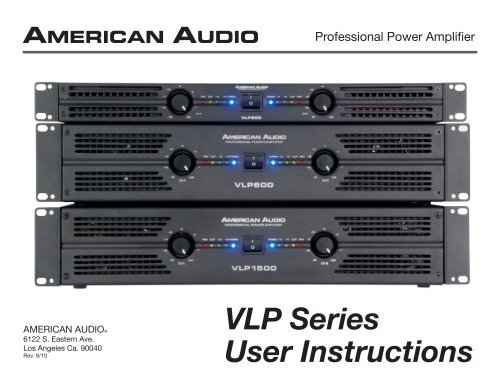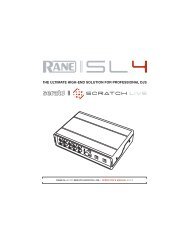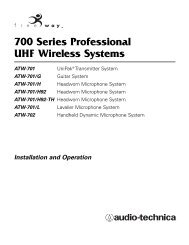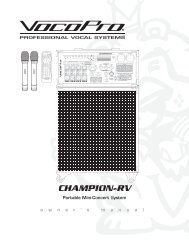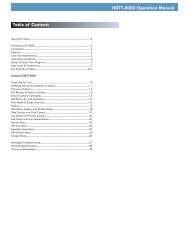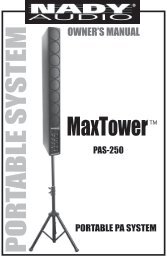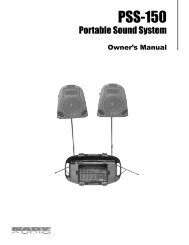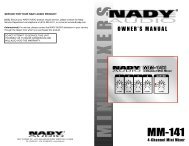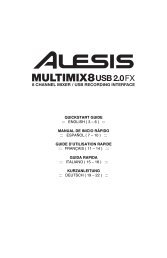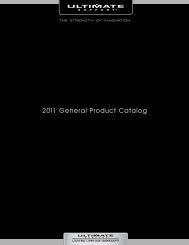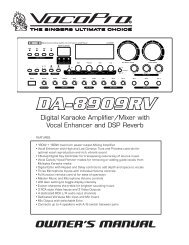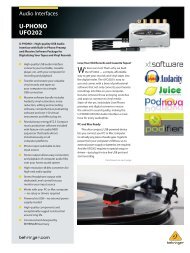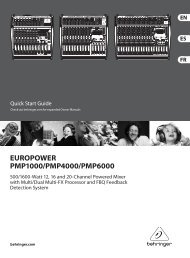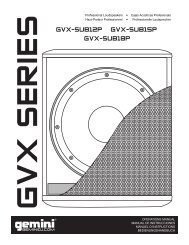VLP Series User Manual - American Audio
VLP Series User Manual - American Audio
VLP Series User Manual - American Audio
- No tags were found...
You also want an ePaper? Increase the reach of your titles
YUMPU automatically turns print PDFs into web optimized ePapers that Google loves.
Professional Power Amplifier<strong>American</strong> <strong>Audio</strong>®6122 S. Eastern Ave.Los Angeles Ca. 90040Rev. 9/10<strong>VLP</strong> <strong>Series</strong><strong>User</strong> Instructions
This symbol is intended to alert the user to the presence of non insulated "dangerous voltage" within the product's enclosure that may be of sufficient magnitude toconstitute a risk of electric shock to persons.This symbol is intended to alert the user of the presence of important operating and maintenance (servicing) instructions in the literature accompanying the product.Caution: Risk of the electrical shock - Do not open!Caution: To reduce the risk of electrical shock, do not remove cover. No user serviceable parts inside. Refer all servicing to qualified service personnel.Warning: To prevent electrical shock or fire hazard, do not expose this amplifier to rain or moisture. Before using this amplifier, read the user manual for further warnings.Este símbolo tiene el propósito de alertar al usuario de la presencia de “voltaje peligroso“ que no tiene aislamiento dentro de la caja del producto que puede teneruna magnitud suficiente como para constituir riesgo de corrientazo.Este símbolo tiene el propósito de alertar al usuario de la presencia de instrucciones importantes sobre la operación y mantenimiento en la literatura que vienc conel producto.Precaución: Riesgo del choque eléctrico - no se abraPrecaución: Para disminuir el riesgo de choque eléctrico, no quite la cubierta. No hay piezas adentro que el usario puede reparar. Deje todo mantenimiento al los técnicoscualificados.Advertencia: Para prevenir choque eléctrico o riesgo de incendios, no deja expuesto a la lluvia o a la humedad este amplificador. Antes de usar este amplificador, leamas advertencias en la guia de operacion.Ce symbole est utilisé pur indiquer à l’utilisateur la présence à l'intérieur de ce produit de tension non-isolée dangereuse pouvant être d'intensité suffisante pourconstituer un risque de choc électrique.Ce symbole est utilisé pour indiquer à l’utilisateur qu'il trouvera d'importantes instructions importantes sur l'utilisation et l'entretien de l'appareil dans la littératureaccompagnant le produit.Attention: Risque de choc électrique - Ne pas ouvrir!Attention: Afin de réduire le risque de choc électrique, ne pas enlever le couvercle. Il ne se trouve à l’intérieur aucune piéce pouvant être réparée par l'utilisateur. Confierl'entretien à un personnel qualifié.Avertissement: Afin de prévenir les risque de décharge ou de feu, n’exposez pas cet appareil à la pluie ou à l’humidité. Avant d’utiliser cet amplificateur, lisez les avertissementssupplémentaries situés dans le guide.Dieses Symobl soll den Anwender vor unisollierten gefährlichen Spannungen innerhalb des Gehäuses warnen, die von Ausreichender Stärke sind, um einen elektrischenSchlag verursachen zu können.Dieses Symobl soll den Benutzer auf wichtige Instruktionen in der Bedienungsanleitung aufmerksam machen, die Handhabung und Wartung des Produkts betreffen.Vorsicht: Risiko - Elektrischer Schlag! Nicht öffnen!Vorsicht: Um ddas Risiko eines elektrischen Schlages zu vermeiden, nicht die Abdeckung enfernen. Es befinden sich keine Teile darin, die vom Anwender repariertwerden könnten. Reparaturen nur von qualifizierte Fachpersonal durchführen lassen.ACHTUNG: Um einen elektrischen Schlag oder Feuergefahr zu vermeiden, sollte diesen Gerät nicht dem Regen oder Feuchtigkeit ausgesetz werden. Vor Inbetriebnahmeunbedingt die Bedienungsanleitung lesen.©<strong>American</strong> <strong>Audio</strong>® - www.americanaudio.us - <strong>VLP</strong> <strong>Series</strong> Power Amplifier <strong>User</strong> <strong>Manual</strong> Page 2
CAUTIONDo not open -risk of electric shockCAUTION: TO REDUCE THE RISK OF ELECTRICSHOCK, DO NOT REMOVE THE COVER.THERE ARE NO USER SERVICEABLE PARTSINSIDE. REFER ALL SERVICE TO YOURAUTHORIZED AMERICAN AUDIO® DEALER.The lightning flash with an arrow triangularsymbol is intended to alert the user to thepresence of non insulated “dangerous voltage”within the products enclosure, andmay be of sufficient magnitude to constitutea risk of electric shock.The exclamation point triangular symbol isintended to alert the user to the presenceof important operating and maintenance(servicing) instructions in the user manualaccompanying the amplifier.FOR OPTIMUM PERFORMANCE ANDRELIABILITY DO NOT PRESENT THEAMPLIFIER WITH A SPEAKER LOADOF LESS THAN 2 OHMS OR ANYCOMBINATION OF SPEAKERS THATTOGETHER ARE LESS THAN 2 OHMS!USING ONE SPEAKER, IT MUST BERATED AT 4 OR MORE OHMS.USING TWO SPEAKERS, THEY MUSTRATED EACH AT 4 OR MORE OHMS.USING THREE SPEAKERS, THEYMUST BE RATED EACH AT 8 OR MOREOHMS.P O U R A S S U R E R L A F I A B I L E T E E TOBTENIT UNE PERFORMANCE OPTIMALE,NESOUMETTE JAMAIS L’AMPLIFICATEURA UNE CHARGE D’IMPEDANCE TOTALEINFERIEURE A 2 OHMS, NI AVEC UN H.P. NIEN COMBINAISON DES H.P.AVEC UN H.P., IL FAUT UNE CHARGED’IMPEDANCE MINIMUM DE 2 OHMS.AVEC DEUX H.P., FAUT POUR CHAOUN UNECHARGE D’IMPEDANCE MINIMUM DE 4OHMS.AVEC TROIS H.P., FAUT POUR CHAOUN UNECHURGE D’IMPEDANCE MINIMUM DE 8OHMS.CONTENTS:Safety Precautions.......................................................................................................................................................................................4Introduction...............................................................................................................................................................................................4Front Panels.................................................................................................................................................................................................5Rear Panels..................................................................................................................................................................................................7Inputs...........................................................................................................................................................................................................9Outputs............................................................................................................................................................................................................9Speakon Output Connector Assembly.......................................................................................................................................................11Operating Modes........................................................................................................................................................................................12Protection CircuitryLimiter.................................................................................................................................................................................................13Short Circuit Protection...................................................................................................................................................................13Thermal Protection..........................................................................................................................................................................14Amplifier Features.......................................................................................................................................................................................14Speaker Setup............................................................................................................................................................................................15Warranty.................................................................................................................................................................................................16Specifications...............................................................................................................................................................................................17©<strong>American</strong> <strong>Audio</strong>® - www.americanaudio.us - <strong>VLP</strong> <strong>Series</strong> Power Amplifier <strong>User</strong> <strong>Manual</strong> Page 3
Important Precautions• To reduce the risk of electrical shock or fire, do not expose thisunit rain or moisture.• do not spill water or other liquids into or on to your unit.• do not attempt to operate this unit if the power cord has beenfrayed or broken.• do not attempt to remove or break off the ground prong fromthe electrical cord. This prong is used to reduce the risk of electricalshock and fire in case of an internal short.• disconnect main power before making any type of connection• do not remove the cover under any conditions. There are nouser serviceable parts inside.• never plug this unit in to a dimmer pack.• Always be sure to mount this unit in an area that will allowproper ventilation. Allow about 6” (15cm) between this deviceand a wall.• do not attempt to operate this unit, if it becomes damaged.• This unit is intended for indoor use only, use of this product outdoorsvoids all warranties.• during long periods of non-use, disconnect the unit’s mainpower.• Always mount this unit in a safe and stable manner.• Power cords should be routed so they are not likely to bewalked on, pinched by items placed upon or against them.• cleaning -The outside of the unit should be wipe down with asoft cloth and mild cleaner when needed.• Heat -The appliance should be situated away from heat sourcessuch as radiators, heat registers, stoves, or other appliances(including amplifiers) that produce heat.• The fixture should be serviced by qualified service personnelwhen:A. The power-supply cord or the plug has been damaged.B. Objects have fallen on, or liquid has been spilled into the unit.c. The appliance has been exposed to rain or water.d. The fixture does not appear to operate normally or exhibits amarked change in performance.IntroductionIntroduction: Congratulations and thank you for purchasingthis <strong>American</strong> <strong>Audio</strong>® <strong>VLP</strong> series amplifier. This amplifier is arepresentation of <strong>American</strong> <strong>Audio</strong>’s continuing commitment toproduce the best and highest quality products all at an affordableprice. Please read and understand this manual completely beforeattempting to operate your new amplifier. This booklet containsimportant information concerning the proper and safe operation ofyour new amplifier.Unpacking: Every <strong>VLP</strong> <strong>Series</strong> amplifier has been thoroughlytested and has been shipped in perfect operating condition.Carefully check the shipping carton for damage that may haveoccurred during shipping. If the carton appears to be damaged,carefully inspect your unit for any damage and be sure all accessoriesnecessary to operate the unit has arrived intact. In the eventdamage has been found or parts are missing, please contact ourtoll free customer support number for further instructions. Pleasedo not return the amplifier to your dealer without contacting customersupport first.Installation: This amplifier is designed to mount into a standard19” rack. The front panel provides four holes used to screw theunit into a rack. The unit also provides a way to rear mount theunit into a rack for added security. Rear mounting the unit is especiallyrecommended for this amplifier if the unit is to mounted intoa mobile rack.Customer Support: <strong>American</strong> <strong>Audio</strong>® provides a toll free customersupport line, to provide set up help and to answer any questionshould you encounter problems during your set up or initial operation.You may also visit us on the web at www.americanaudio.usfor any comments or suggestions. For service related issue pleasecontact <strong>American</strong> <strong>Audio</strong>®. Service Hours are Monday throughFriday 9:00 a.m. to 5:00 p.m. Pacific Standard Time.Voice: (800) 322-6337Fax: (323) 582-2610©<strong>American</strong> <strong>Audio</strong>® - www.americanaudio.us - <strong>VLP</strong> <strong>Series</strong> Power Amplifier <strong>User</strong> <strong>Manual</strong> Page 4E-mail: support@americanaudio.com
PROFESSIONAL POWER AMPLIFIERFront Panel<strong>VLP</strong>600 & <strong>VLP</strong>15001 2 3 4 5 6 5 7 8 9 101063106315 PRO CLIP 10 15 POWERPOWER 15 10 CLIP PRO1530130180CH A0 dB80CH B0 dB<strong>VLP</strong>1500Figure 11. Channel 1 Gain Control - This rotary knob is used to control the outputsignal of channel one. Turning the knob in a clockwise direction willincrease signal output.2. Channel 1 Protect Indicator - The red Protect LED will begin to glowwhen the channel goes into protect mode. When the channel goes intoprotect mode all output for that channel will turn off. This is to protect anyspeakers connected to the channel.3. Channel 1 Clip Indicator - This red LED will begin to flash whenchannel one begins to overload (clip). At this point channel one will beginto distort. Under heavy clipping activity lower the channel one gaincontrol to reduce the risk of damage to your speakers and amplifier. ThisLED may glow when the unit has been turned off, this is normal.4. Channel 1 Signal Indicators - These green and yellow LED’s will glowaccording to the average signal output.5. Function Indicators - These indicators detail the operating mode ofthe amplifier. These LEDs will also function as a power indicator.6. Power Switch - This switch is used to control the units main power.7. Channel 2 Signal Indicators - These green and yellow LED’s will glowaccording to the average signal output.8. Channel 2 Clip Indicator - This red LED will begin to flash whenchannel one begins to overload (clip). At this point channel one will beginto distort. Under heavy clipping activity lower the channel one gaincontrol to reduce the risk of damage to your speakers and amplifier. ThisLED may glow when the unit has been turned off, this is normal.9. Channel 2 Protect Indicator - The red Protect LED will begin to glowwhen the channel goes into protect mode. When the channel goes intoprotect mode all output for that channel will turn off. This is to protect anyspeakers connected to the channel.10. Channel 2 Gain Control - This rotary knob is used to control theoutput signal of channel two. Turning the knob in a clockwise directionwill increase signal output.©<strong>American</strong> <strong>Audio</strong>® - www.americanaudio.us - <strong>VLP</strong> <strong>Series</strong> Power Amplifier <strong>User</strong> <strong>Manual</strong> Page 5
PROFESSIONAL POWER AMPLIFIERFront Panel<strong>VLP</strong>30011 12 13 14 15 16 15 17 18 19 206610310315 PRO CLIP 10 15 POWERPOWER 15 10 CLIP PRO15301301800 dBCH A<strong>VLP</strong>300CH B800 dBFigure 211. Channel 1 Gain Control - This rotary knob is used to control theoutput signal of channel one. Turning the knob in a clockwise directionwill increase signal output.12. Channel 1 Protect Indicator - The red Protect LED will begin toglow when the channel goes into protect mode. When the channel goesinto protect mode all output for that channel will turn off. This is to protectany speakers connected to the channel.13. Channel 1 Clip Indicator - This red LED will begin to flash whenchannel one begins to overload (clip). At this point channel one will beginto distort. Under heavy clipping activity lower the channel one gaincontrol to reduce the risk of damage to your speakers and amplifier. ThisLED may glow when the unit has been turned off, this is normal.14. Channel 1 Signal Indicators - These green and yellow LED’s willglow according to the average signal output.15. Power Indicators - These LEDs function as a power indicator.16. Power Switch - This switch is used to control the units main power.17. Channel 2 Signal Indicators - These green and yellow LED’s willglow according to the average signal output.18. Channel 2 Clip Indicator - This red LED will begin to flash whenchannel one begins to overload (clip). At this point channel one will beginto distort. Under heavy clipping activity lower the channel one gaincontrol to reduce the risk of damage to your speakers and amplifier. ThisLED may glow when the unit has been turned off, this is normal.19. Channel 2 Protect Indicator - The red Protect LED will begin toglow when the channel goes into protect mode. When the channel goesinto protect mode all output for that channel will turn off. This is to protectany speakers connected to the channel.20. Channel 2 Gain Control - This rotary knob is used to control theoutput signal of channel two. Turning the knob in a clockwise directionwill increase signal output.©<strong>American</strong> <strong>Audio</strong>® - www.americanaudio.us - <strong>VLP</strong> <strong>Series</strong> Power Amplifier <strong>User</strong> <strong>Manual</strong> Page 6
Rear Panel Control<strong>VLP</strong>600 & <strong>VLP</strong>150021 22 23 24 2526 27 2821363534 33 32 3130 29Figure 321. Cooling Fans - Dual high speed cooling fans22. Channel 2 XLR Input - Channel two 3-pin XLR balanced input jack. Seepage 9 for more details.23. Channel 2 TRS Input - Channel two 1/4” female jack. Excepts either a balancedor unbalanced plug. See page 9 for more details.24. Mode Switch - This switch controls the amplifier’s operating mode. Theamplifier can operate in three different modes; Mono Bridge, Stereo, or ParallelMono. The amplifier is shipped in stereo mode.25. Ground On/Off Switch - If hear a hum or any interference, put the Groundswitch in the “On” postion .26. Channel 2 Speakon Output - Optional speaker output connections. Usepins 1+ and 1- of this 4-pole Speakon connector to connect to your speaker’sSpeakon input jack.27. Channel 2 Output Jack/5 way Binding Post - Connect to your speaker’sinput jack. Red is positive signal and Black is negative signal.28. AC Cord - Plug this cable into a standard wall outlet. Check that the voltagein your area matches the amplifiers required voltage.29. Fuse Holder - This housing stores a 15 amp GMA protective fuse for the<strong>VLP</strong> 600 and 30 amp GMA protective fuse for the <strong>VLP</strong> 1500. Never defeat thefuse, the fuse is designed to protect the electronics in the event of severe powerfluctuations. Always be sure to replace the fuse with an exact match as the onebeing replaced, unless otherwise told to do so by an authorized <strong>American</strong> <strong>Audio</strong>®service technician.30. Channel 1 Output Jack/5 way Binding Post - Connect to your speaker’sinput jack. Red is positive signal and Black is negative signal.31. Channel 1 Speakon Output - Optional speaker output connections. Usepins 1+ and 1- of this 4-pole Speakon connector to connect to your speaker’sSpeakon input jack.32. Filter Switch - This switch controls the amplifier’s filter mode. The amplifiercan operate in three different filter modes; High Pass, Low Pass, and By-Pass.33. Sensitivity Switch - This switch lets you choose the input sensitivity.34. Channel 1 TRS Input - Channel one 1/4” female jack. Excepts either a balancedor unbalanced plug. See page 9 for more details.35. Channel 1 XLR input - Channel one 3-pin XLR balanced input jack. Seepage 9 for more details.36. Limiter Switch - This switch is used to limit the input level. Use this functionto avoid damage to your speakers.©<strong>American</strong> <strong>Audio</strong>® - www.americanaudio.us - <strong>VLP</strong> <strong>Series</strong> Power Amplifier <strong>User</strong> <strong>Manual</strong> Page 7
Rear Panel Control37 38 39 40 41 42 43 44 45 46 47 48 495051Figure 437. AC Cord - Plug this cable into a standard wall outlet. Check that the voltagein your area matches the amplifiers required voltage.38. Channel 1 TRS Input - Channel one 1/4” female jack. Excepts either a balancedor unbalanced plug. See page 9 for more details.39. Channel 1 XLR input - Channel one 3-pin XLR balanced input jack. Seepage 9 for more details.40. Mode Switch - This switch controls the amplifier’s operating mode. Theamplifier can operate in three different modes; Mono Bridge, Parallel Mono, orStereo. The amplifier is shipped in stereo mode.41. Channel 2 XLR Input - Channel two 3-pin XLR balanced input jack. Seepage 9 for more details.42. Channel 2 TRS Input - Channel two 1/4” female jack. Excepts either a balancedor unbalanced plug. See page 9 for more details.43. Filter Switch - This switch controls the amplifier’s filter mode. The amplifiercan operate in three different filter modes; High Pass, Low Pass, and By-Pass.44. Sensitivity Switch - This switch lets you choose the input sensitivity.45. Ground On/Off Switch - If hear a hum or any interference, put the Groundswitch in the “On” postion .46. Channel 2 Output Jack/5 way Binding Post - Connect to your speaker’sinput jack. Red is positive signal and Black is negative signal.47. Channel 1 Output Jack/5 way Binding Post - Connect to your speaker’sinput jack. Red is positive signal and Black is negative signal.48. Channel 1 Speakon Output - Optional speaker output connections. Usepins 1+ and 1- of this 4-pole Speakon connector to connect to your speaker’sSpeakon input jack.49. Channel 2 Speakon Output - Optional speaker output connections. Usepins 1+ and 1- of this 4-pole Speakon connector to connect to your speaker’sSpeakon input jack.50. Cooling Fans - Dual high speed cooling fans50. Fuse Holder - This housing stores a 8 amp GMA protective fuse. Neverdefeat the fuse, the fuse is designed to protect the electronics in the event ofsevere power fluctuations. Always be sure to replace the fuse with an exactmatch as the one being replaced, unless otherwise told to do so by an authorized<strong>American</strong> <strong>Audio</strong>® service technician.©<strong>American</strong> <strong>Audio</strong>® - www.americanaudio.us - <strong>VLP</strong> <strong>Series</strong> Power Amplifier <strong>User</strong> <strong>Manual</strong> Page 8
Set UpINPUTS - The <strong>VLP</strong> <strong>Series</strong> amplifier allows you to use two types of input connector per a channel, a XLR jack for balanced connectionsand a 1/4” female jack that will accept balanced and unbalanced connectors. Use these connections to connect the output signalfrom a mixer, cross-over or EQ to your <strong>VLP</strong> <strong>Series</strong> amplifier. A balanced connection is recommended for cable runs longer that 20ft.When constructing your own XLR cables follow the pin configuration describe below for proper connections. For cable runs shorterthan 20ft. you may choose the 1/4” unbalanced input option. The 1/4” unbalanced input option may be more convenient for mostusers due to the abundant supply of prefabricated cables available at your local audio dealer.Male XLR Pin Configuration:Us Itt standardBalanced TRS 1/4” PlugUnbalanced TS 1/4” Plug231Figure 5Figure 6Figure 72 Hot (+ data)3 Negative (- data)1 Ground/Return/ 0v)Hot (+) Ground/ShieldNegative (-)Hot (+)Negative (-)OUTPUTS:Binding Post/Banana Plug - Connect your speakers to the binding post outputs on the rear of the amplifier. Thespeaker wire may be connect by bare wire (directly connected, usually for permanent connections), banana plug,or spade connector. Connections are made to Channels 1 and 2 output’s for stereo mode or across the red terminalsof Channels 1 and 2 for Mono Bridge Mode.Important Notice: Although a speaker will operate with the positive and negative leads plugged into either terminalon the amplifier binding post, be sure to plug the negative lead into the black terminal and positive leadinto the red terminal. Ensuring proper polarity will avoid speakers being out of phase, that can cause a loss ofbass response.Important Notice: Banana Plugs - When connecting your speakers to the amplifier using banana jacks; Be sure that the red and blackcaps on the binding post are completely screwed in. Insert the banana jacks into the caps of the binding post, be sure that the bananajack is inserted securely to avoid the risk of it popping out.©<strong>American</strong> <strong>Audio</strong>® - www.americanaudio.us - <strong>VLP</strong> <strong>Series</strong> Power Amplifier <strong>User</strong> <strong>Manual</strong> Page 9Figure 8
Bare Wire Connections: (Figure 9)When connecting your speakers to the amplifier using bare wire; Unscrew the red andblack caps on the binding post, be sure not to completely remove or unscrew the redand black caps. Strip back the wire insulation 1/2” (13mm). Insert the bare wire into thehole that was reveled by unscrewing the binding post cap. After inserting the wire intothe binding post hole, screw the binding post cap down on the wire. To reduce the risk ofshock or damage to your amplifier, be sure that the wire connected to one binding postdoes not come in contact with that of another.Spade Connector: (Figure 10)When connecting your speakers to the amplifier using spade connector; Unscrew the red and black caps onthe binding post, be sure not to completely remove or unscrew the red and black caps. Insert the spade connectorin to the binding post and tighten the caps down on the spade connector. To reduce the risk of shockor damage to your amplifier, be sure that the wire connected to one binding post does not come in contactwith that of another.When connecting your speakers to the amplifier using banana jacks; Be sure that the red and black caps onthe binding post are tighten down completely. Insert the banana jacks into the caps of the binding post, besure that the banana jack is inserted securely to avoid the risk of it popping out.Mono Bridge Connections:Mono bridge operation connections will follow the above descriptions however, when operating in monobridge operation the speaker connections will run between the two positive (red) leads. Use channel two positiveoutput terminal for the negative connection and the channel one positive output terminal for the positiveconnection.Stereo Connections Using the Neutrik Speakon output connectors:Figure 9Typical speaker output using bare wire. Insertbare wire into the binding post and tighten.Figure 10Typical speaker output usingspade connectors. Insertbare wire into the bindingpost and tighten.Recent regulatory requirements in Europe have outlawed the use of the dual banana plug and force amp users to terminate their speakercables with spade lugs or bare wire ends. This is not advantageous to most users that want to reconfigure their systems or quicklychange out an amp. The Neutrik Speakon® connector provides the most convenient solution to this problem, eliminating the need forspade plugs or bare wire end cables. Major speaker manufacturers have been using Speakon connectors on their products for years,so chances are you are ready to use the Speakon connection. With Speakon connectors, you can connect straight from the amplifierto the speaker. The Speakon connector used on this amplifier meets all known safety regulations. Once wired correctly, the connectorcannot be plugged in backwards, causing the type of inverted polarity situations that have become common with banana hookups. Thisconnection will provide a safe, secure and reliable method of connecting your speakers to your new amplifier. You can purchase theSpeakon® NL4FC connectors from your local audio dealer.©<strong>American</strong> <strong>Audio</strong>® - www.americanaudio.us - <strong>VLP</strong> <strong>Series</strong> Power Amplifier <strong>User</strong> <strong>Manual</strong> Page 10
SPEAKON1+ HOT1 COLDMINIMUM LOAD IMPEDANCE 2 OHM PERCHANNEL 4 OHM BRIDGESpeakon Assembly: You will need a pair of Neutrik Speakon® NL4FCconnectors. You will also need high-quality two or four conductor speakercable, a pair of needle-nosed pliers and a 1.5-mm Allen key to assemble theSpeakon connectors to your speaker wire. To assemble the Neutrik SpeakonNL4FC connector, complete the following steps:1. Strip back 3/4-inch of the cable casing. Strip off 1/4-inch from the end ofeach of the conductors down to bare wire, and insert the brass fittings. SeeFigure 11.2. Slide the cable tension clip (D) and the speakon coupler (E) through thecable end. See Figure 12.3. Insert each wire with the brass fittings into the top of appropriate slot of theconnector insert (B) as shown in Figures 12 and 13. Use a 1.5-mm Allen keyto tighten the connection. See Figure 13.4. Be sure to properly match the positive (+) and negative (–) leads of eachwire. See Figure 14.5. Slide the connector insert (B) into the connector housing (A), making surethat the large notch on the outer edge of the insert lines up with the largegroove on the inside of the connector housing. The insert should slide easilythrough the housing and out the other side until it extends approximately 3/4-inch from the end of the housing.6. Slide the cable tension clip (D) along the cable and insert into the housing(A), making sure that the large notch lines up with the large groove on theinside of the connector housing (A). The cable tension clip (D) should slideeasily into the housing until only 3 /8-inch of the cable tension clip (D) extendsfrom the back end of the connector.7. Slide the coupler (E) along the cable and screw it onto the end of thehousing (A). Before tightening, you may want to test the connector to makesure it has been assembled properly.Figure 11Brass insertsFigure 12AFigure 13Figure 14Bc4-conductor Speaker cabledeINPUT BANCEINPUT TUCAUTIONC 2 UTPUTS - B ID E +C 1NC 2C 1120604800 ATTS+-+ - +-1+1+2+1+2++2-1+2©<strong>American</strong> <strong>Audio</strong>® - www.americanaudio.us - <strong>VLP</strong> <strong>Series</strong> Power Amplifier <strong>User</strong> <strong>Manual</strong> Page 11
Operating Modes: Always configure your amplifier operating mode before beginning operation. If you want to change it duringperformance. You must decrease the gain controls to their lowest levels to protect the speakers from any popping noise.Stereo Operation - Page 15/Figure 15 details an example of a typical stereo set-up. Connect your inputs into channels one andtwo of the amplifier. Connect your speakers to the outputs on the rear of the amplifier. Be sure that your front gain controls are turneddown to their lowest level (full counter-clockwise). Turn your amp on. Turn your input source level up. Use your front gain controls toregulate the output volume. Be sure not to raise the volume to the clip level, however an intermittent clip signal is acceptable.Mono Bridge Operation - Page 15/Figure 16 details a mono bridge set-up. Be sure your amplifier and all other audio equipmentis powered down. Flip the Stereo/Mono Bridge switch to the Mono Bridge position. Connect an input signal to channel one. Connectyour speaker across the red output binding post on the rear of your amplifier. Turn your equipment on (your amplifier should alwaysbe the last item you turn on). Apply an input source signal to your amplifier. Turn channel two gain up. Use the channel one gain toregulate your amplifier output.Bridged-Mono Mode Caution - The voltage across the output terminals of a bridged <strong>VLP</strong> <strong>Series</strong> amplifier may equal or exceed100 volts RMS and may be as high as 130 volts. Use fully insulated CLASS ONE wiring, and the load must be rated for up to 2500 watts(@4 ohms)Parallel Mono - “Parallel ” ties the two channel line inputs together so that they will both be driven by the same signal, without theneed for external jumpers or wiring. Both amplifier channels will operate independently. Though they carry the same signal, their gaincontrols affect only their respective channels, and they both must use their respected speaker outputs. Never attempt to parallel thespeaker outputs, this may cause serious damage to your amplifier! This mode is recommended when using the <strong>VLP</strong> <strong>Series</strong> to run bassspeakers, to achieve better low end. To run in parallel mono mode connect your system as you would if you were going to run in stereomode. Then flip the mode switch to “MONO.” Be sure the amp is off or the power is disconnected before making any changes.©<strong>American</strong> <strong>Audio</strong>® - www.americanaudio.us - <strong>VLP</strong> <strong>Series</strong> Power Amplifier <strong>User</strong> <strong>Manual</strong> Page 12
Mono Subwoofer - This operation is similar to the Stereo Subwoofer operation but in mono. When running subwoofers it is usuallyrecommended to run them in mono mode to achieve a cleaner tighter low end. This operation allows you to run several subwoofersdown to a minimum of 4 ohms. To avoid amplifier overheating, never run the amplifier below 8 ohms in this mode. Set up this modeas you would a standard stereo set up. In this mode you may use the frequency adjustment on the rear of the amp, to control the bassfrequency output level. Frequencies may be adjusted from 20Hz to 200Hz.PROTECTION:Limiter - Only the <strong>VLP</strong> 1500 and 600 come with a built in limiter. When the input signal overloads, the “CLIP LED’s” indicate a signaloverload, at this time, the master volume should be lowered to reduce distortion. If the input gain level is not reduced the built-inlimiter will activate. During signal overload, the limiter will reduce the input audio signal enough to minimize the amount of clipping.A limiter takes the gain of an overloading signal and reduces it, the reduction in gain reduces distortion that can cause damage toyour speakers and amplifier. During normal operation below clipping, and momentary clips on peaks, the limiter does not affect theaudio signal and is inaudible. It will allow brief clipping of peaks and will only activate when continuous, hard clipping occurs. Duringexcessive clipping the limiter will reduce the audio signal enough to minimize the amount of clipping. When the input signal decreasesenough that clipping ends, the limiter will deactivate and cease its gain reduction. The limiter has a fixed threshold and can not beadjusted.Safe Power Levels at Different Output Loads:8-Ohm Loads: The amplifier can operate at practically any power level without risk of overheating. However, if it is pushed hardenough to continually light the “CLIP ” indicator, the amplifier’s average output power can reach 150 watts.4-Ohm Loads: If the “CLIP” indicator flashes occasionally, the amplifier is approaching its maximum long-term power capacity. If it islit about half the time, the amplifier channel will probably go into thermal protection within a few minutes.Short Circuit Protection - The <strong>VLP</strong> <strong>Series</strong> amplifiers all come with built-in Output Short Circuit Protects. The Output Short CircuitProtection protects the output devices of the amplifier from short circuits and stressful loads. If your speaker lines short, the amplifierautomatically detects this problem and discontinues operation for that channel. If one side of your amplifier becomes shorted andgoes into protect mode, the other side will continue to operate normally. During short circuit protection, the "Clip" LED and “Protect"LED will light simultaneously indicating amplifier fault. All channel output during the “Short Circuit Protection" will be interrupted (i.e.no sound out©<strong>American</strong> <strong>Audio</strong>® - www.americanaudio.us - <strong>VLP</strong> <strong>Series</strong> Power Amplifier <strong>User</strong> <strong>Manual</strong> Page 13
put). Short Circuit Protection can usually be traced back to the signal output line (i.e. speaker line). Check the line from the output terminalof the amplifier to the speaker. If this line good, check the internal speaker connections and components. A short circuit will usuallybe traced to a bad cable or a bad speaker component and is rarely traced to the amplifier itself.Thermal Protection - Dual variable speed fans on the <strong>VLP</strong> <strong>Series</strong> amplifier provide adequate cooling. During low level output the fansrun at normal speeds. During high output and as heat raises, (exceeding 90°C.), the fans will run at higher speeds to aid the coolingprocess. If the heatsink temperature exceeds 91°C., the amplifier will mute until the amplifier cools down. When the amplifier coolsbelow 90°C., the amplifier will return to normal operations. Be sure not to operate your amplifier below the minimum load ratings toreduce the risk of overheating problems.Input/Output Protection - The input circuits are isolated by 10k resistors. An ultrasonic network uncouples RF from the output andhelps keep the amplifier stable with reactive loads.Operating Voltage (AC Mains) - The serial number label indicates the correct AC main voltage. Connecting to the wrong voltage isdangerous and may damage the amplifier. Always be sure the source voltage for your areas matches the required voltage for youramplifier.Gain Controls - The gain controls are located on the front panel and are calibrated in 2dB of attenuation from full gain. It is best toadjust the amplifier so no “hissing” is heard from speakers with no music being played, this will ensure the lowest possible distortionduring normal operation.AMPLIFIER FEATURES:THRU - Thru will allow the user to daisy-chain one amplifiers signal input into another amplifier. Plug the signal source outputs into thefirst amplifier’s input, patch from the amplifier’s THRU jacks to the next amplifier’s input, and so on, daisy-chaining as many amplifiersas there is no excessive level loss. Is not affected by crossover setting.GROUND LIFT SWITCH - Applying or lifting the ground switch will change the level for background noise and hum, if the noise levelremains the same in either position, it is better to keep the ground lift switch in the ground position. This will eliminate 60Hz cycle humthat is sometimes induced when mounting several units in the same rack.OPERATING VOLTAGE (AC MAINS) - The serial number label indicates the correct AC main voltage. Connecting to the wrong voltageis dangerous and may damage the amplifier.GAIN CONTROLS - The gain controls are located on the front panel and are calibrated in 2dB of attenuation from full gain. It is best toadjust the amplifier so no “hissing” is heard from speakers with no music being played, this will ensure the lowest possible distortionduring normal operation.LED INDICATORS - Each channel has five LEDS. Two LEDs indicate signal level activity; two green LEDs. One yellow LED indicatessignal clipping. One red LED indicates protections mode for shorts/ overload. One blue LED indicates power for each individual channel.©<strong>American</strong> <strong>Audio</strong>® - www.americanaudio.us - <strong>VLP</strong> <strong>Series</strong> Power Amplifier <strong>User</strong> <strong>Manual</strong> Page 14
Figure 15Typical Stereo Output ConnectionsUse Speakon or Banana JacksSPEAKERS4 OHM MINIMUMTYPICAL Mono bridge SET-UPSPEAKERS4 OHM MINIMUMUse Channel 1 Inputs Only (XLR or 1/4” Jacks)Figure 16XUse the two positive binding posttermainals (red) for speaker output.SPEAKERS8 OHM MINIMUM©<strong>American</strong> <strong>Audio</strong>® - www.americanaudio.us - <strong>VLP</strong> <strong>Series</strong> Power Amplifier <strong>User</strong> <strong>Manual</strong> Page 15
The <strong>VLP</strong> series carries a one year limited warranty. We recommend you fill out the enclosed warranty card to validate your purchase. Allreturned service items whether under warranty or not, must be freight pre-paid and accompany a R.A. (return authorization) number. If themixer is under warranty, you must provide a proof of purchase invoice. You may obtain a R.A. number by contacting our customer supportteam on our toll free number. Please contact <strong>American</strong> <strong>Audio</strong>® customer support at (800) 322-6337 for a R.A. number. All packagenot displaying a R.A. number on the outside of the package will be returned to the shipper.1-YEAR LIMITED WARRANTYA. <strong>American</strong> <strong>Audio</strong>® hereby warrants, to the original purchaser, <strong>American</strong> <strong>Audio</strong>® products to be free of manufacturing defects in material and workmanshipfor a period of 1 Year (365 days) from the date of purchase. This warranty shall be valid only if the product is purchased within the UnitedStates of America, including possessions and territories. It is the owner’s responsibility to establish the date and place of purchase by acceptableevidence, at the time service is sought.B. For warranty service, send the product only to the <strong>American</strong> <strong>Audio</strong>® factory. All shipping charges must be pre-paid. If the requested repairs orservice (including parts replacement) are within the terms of this warranty, <strong>American</strong> <strong>Audio</strong>® will pay return shipping charges only to a designatedpoint within the United States. If the entire instrument is sent, it must be shipped in its original package. No accessories should be shipped withthe product. If any accessories are shipped with the product, <strong>American</strong> <strong>Audio</strong>® shall have no liability whatsoever for loss of or damage to any suchaccessories, nor for the safe return thereof.C. This warranty is void if the serial number has been altered or removed; if the product is modified in any manner which <strong>American</strong> <strong>Audio</strong>® concludes,after inspection, affects the reliability of the product; if the product has been repaired or serviced by anyone other than the <strong>American</strong> <strong>Audio</strong>®factory unless prior written authorization was issued to purchaser by <strong>American</strong> <strong>Audio</strong>®; if the product is damaged because not properly maintainedas set forth in the instruction manual.D. This is not a service contract, and this warranty does not include maintenance, cleaning or periodic check-up. During the period specified above,<strong>American</strong> <strong>Audio</strong>® will replace defective parts at its expense, and will absorb all expenses for warranty service and repair labor by reason of defectsin material or workmanship. The sole responsibility of <strong>American</strong> <strong>Audio</strong>® under this warranty shall be limited to the repair of the product, or replacementthereof, including parts, at the sole discretion of <strong>American</strong> <strong>Audio</strong>®. All products covered by this warranty were manufactured after January 1,1990, and bear identifying marks to that effect.E. <strong>American</strong> <strong>Audio</strong>® reserves the right to make changes in design and/or improvements upon its products without any obligation to include thesechanges in any products theretofore manufactured.F. No warranty, whether expressed or implied, is given or made with respect to any accessory supplied with products described above. Except tothe extent prohibited by applicable law, all implied warranties made by <strong>American</strong> <strong>Audio</strong>® in connection with this product, including warranties ofmerchantability or fitness, are limited in duration to the warranty period set forth above. And no warranties, whether expressed or implied, includingwarranties of merchantability or fitness, shall apply to this product after said period has expired. The consumer’s and or Dealer’s sole remedy shallbe such repair or replacement as is expressly provided above; and under no circumstances shall <strong>American</strong> <strong>Audio</strong>® be liable for any loss or damage,direct or consequential, arising out of the use of, or inability to use, this product.G. This warranty is the only written warranty applicable to <strong>American</strong> <strong>Audio</strong>® products and supersedes all prior warranties and written descriptionsof warranty terms and conditions heretofore published.<strong>American</strong> <strong>Audio</strong>® - www.americanaudio.us - <strong>VLP</strong> <strong>Series</strong> Power Amplifier <strong>User</strong> <strong>Manual</strong> Page 16
<strong>VLP</strong> SERIES SPECSPower supply:AC 100V, 50/60Hz (Japan)AC 110V, 60Hz (Colombia)AC 120V, 60Hz (U.S.A. and Canada)AC 127V, 60Hz (Mexico)AC 220V, 50Hz (Chile and Argentina)AC 220V, 60Hz (Philippines and Korea)AC 230V, 50Hz (Europe, New Zealand, South Africa, and Singapore)AC 240V, 50Hz (Australia and U.K.)MODEL: <strong>VLP</strong> 300 <strong>VLP</strong> 600 <strong>VLP</strong> 1500Output Power:150W RMS per Channel @ 4 Ohms, 300W RMS per Channel @ 4 Ohms, 750W RMS per Channel @ 4 Ohms,1kHz, 0.1% THd 1kHz, 0.1% THd 1kHz, 0.1% THD100W RMS per Channel @ 8 Ohms, 200W RMS per Channel @ 8 Ohms, 500W RMS per Channel @ 8 Ohms,1kHz, o.1% THD 1kHz, 0.1% THD 1kHz, 0.1% THD(Bridge Mode, Mono) (Bridge Mode, Mono) (Bridge Mode, Mono)300W RMS @ 4 Ohms, 600W RMS @ 4 Ohms, 1500W RMS @ 4 Ohms,1kHz, 1% THd 1kHz, 1% THD 1kHz, 1% THDTotal Harmonic Less Then 0.1% (20Hz - 20kHZ @ Less Then 0.1% (20Hz - 20kHZ @ Less Then 0.1% (20Hz - 20kHZ @Distortion (THD): 8 Ohms 8 Ohms 8 OhmsFrequency (+/-01db, @ rated output power, (+/-01db, @ rated output power, (+/-01db, @ rated output power,Response: 8 Ohms): 20Hz - 20KHz 8 Ohms): 20Hz - 20KHz 8 Ohms): 20Hz - 20KHzSlew Rate: 15V Per usec 15V Per usec 15V Per useDamping Factor @ 260 300 3008 Ohm:Impedance: 20K Ohms Balanced 20K Ohms Balanced 20K Ohms Balanced10K Ohms Unbalanced 10K Ohms Unbalanced 10K Ohms UnbalancedDimensions 13.25” x 19” x 1.75” 14” x 19” x 3.5” 14” x 19” x 3.5”(LxWxH): 336 x 482 x 44mm 360 x 482 x 88mm 360 x 482 x 88mmWeight: 24lbs/11Kgs 33lbs/15Kgs 42lbs/19Kgs<strong>American</strong> <strong>Audio</strong>® - www.americanaudio.us - <strong>VLP</strong> <strong>Series</strong> Power Amplifier <strong>User</strong> <strong>Manual</strong> Page 17
©<strong>American</strong> <strong>Audio</strong>® World Headquarters:6122 S. Eastern Ave. Los Angeles, CA 90040 USATel: 323-582-3322 Fax: 323-725-6100Web: www.<strong>American</strong><strong>Audio</strong>.us E-mail: info@americanaudio.us<strong>American</strong> DJ EuropeJunostraat 26468 EW KerkradeNetherlandsservice@americandj.eu / www.americandj.euTel: +31 45 546 85 00 / Fax: +31 45 546 85 99


